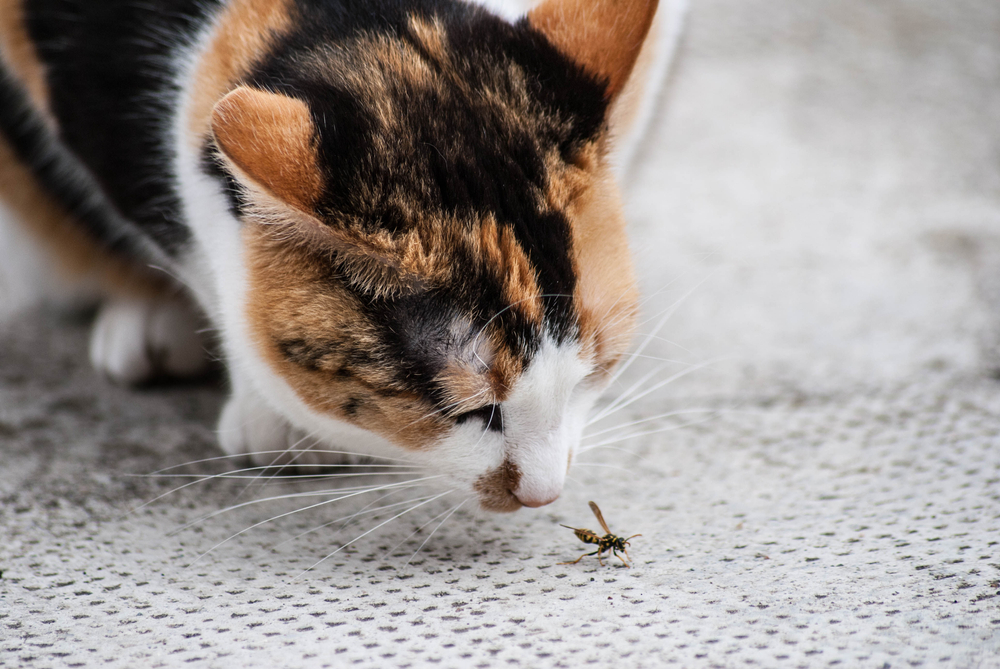With their curious nature and desire to stalk and pounce on tiny flying, jumping, or buzzing bugs, your pet can land in a heap of trouble if they hunt the wrong insect. While some pests are more dangerous than others, anything that bites or stings your pet can cause an allergic reaction, and may envenomate your furry friend.
By learning how to identify what bug attacked your pet, you can treat them correctly and quickly to safely soothe the bite or sting, and possibly prevent a more serious reaction. Follow our Star of Texas Veterinary Hospital team’s step-by-step guide on treating your pet after an altercation with a bug.
Step 1: Determine where your pet was bitten or stung
You may have seen your pet exploring that corner spiderweb, or tangling with the buzzing bee that somehow was on the inside of the window, and then hearing a yowl of pain. Your pet ventured too close to an angry, defensive bug and suffered the consequences. Now, where is the injury?
While most insects bite and sting the face or paw—the body parts your pet uses to investigate—certain bugs like particular areas on pets. For example, fleas generally set up shop on a pet’s head, neck, groin, and tail base, whereas ticks prefer the head, ears, and limbs. Flying bugs can attack anywhere on your pet’s body, while ants and spiders will bite at the point of contact.
Comb through your pet’s fur to find the bite or sting site, which will need treating and monitoring. You may not be able to identify the area until swelling and redness set in.
Step 2: Make an educated guess about what bit or stung your pet
Evaluating your pet’s injury will help you identify the pest that attacked, especially if they are still attached. The most common insects, bugs, and arachnids that harm pets include:
- Fleas — Fleas are among the tiniest parasites that can bug your pet. Fleas are dark brown, have six legs, and can leap impressive distances. Despite their small size, they can cause intense itching that can lead to hair loss, hot spots, skin infections, and extreme skin irritation in an allergic pet.
- Ticks — Larval, nymph, and adult ticks can all feed on your pet, so accurate identification is difficult. Larval ticks can be as microscopic as a sesame seed, whereas adult ticks that have recently fed can be the size of a small grape. In general, ticks are various shades of brown, red, or gray, and some species have unique markings.
- Mosquitoes — Mosquitoes are typically easily identifiable, because if they are feasting on your pet, they are also likely making a meal out of you. With their long proboscis (i.e., mouthpart), they can inflict itchy discomfort as they feed.
- Flies — Correctly identifying a fly before it—well, flies off—can be challenging. Fly species vary greatly, but their bites generally cause some discomfort, no matter the species or size.
- Spiders — Two main spider groups are responsible for serious problems in pets—the widow and the recluse spiders. Black widow spiders are a dark gray or black, with a hallmark red or orange hourglass mark on their abdomen. Brown recluse spiders are yellow-brown with a violin-shaped marking on their backs.
- Bees, wasps, and hornets — While all these flying insects are yellow and black, bees tend to be fuzzy and round, whereas wasps and hornets have a shiny shell and a gangly body.
Step 3: Remove the irritant from your pet
Whether you discover a flea infestation, bee stinger, or a tick on your pet, you need to safely remove the irritant before they will heal. Depending on what bug you find, you may need a specific “tool” for removal. A tick-removal key can efficiently remove a tick, mouthparts and all, and a credit card can scrape out a bee stinger. Applying prescription flea prevention is the safest way to kill fleas on your pet.
Step 4: Administer first aid treatment as needed
Before administering any oral or topical medication to your pet, contact your Star of Texas Veterinary Hospital veterinarian for appropriate recommendations. Depending on your pet’s health status, their current prescriptions, and the bite or sting type, you may be instructed to administer an antihistamine or hydrocortisone product, or to fit your pet with an Elizabethan collar (i.e., e-collar).
Step 4: Monitor your pet for a potential allergic reaction

While allergic pets typically react to bug bites and stings only minutes after the injury, delayed reactions can occur. Watch your pet closely for signs of an anaphylactic reaction, which requires emergency treatment. Rush your pet to the veterinarian immediately If you notice the following problems:
- Difficulty breathing
- Facial swelling
- Vomiting or diarrhea
- Excessive drooling
- Disorientation
- Loss of balance
Bugs, insects, arachnids, and all classifications of creepy-crawly pests have the potential to trigger an allergic reaction in your pet. If you see your pet reacting adversely to a bug bite or sting, contact our Star of Texas Veterinary Hospital team for help.





